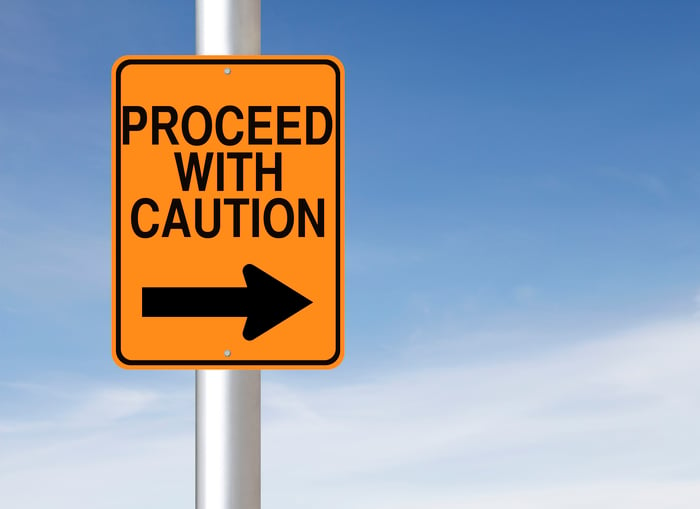If I'd observed all the rules, I'd never have got anywhere. -- Marilyn Monroe
Marilyn Monroe may have been on to something. Obeying all the rules may lead to a boring life -- and, perhaps, suboptimal results. After all, Fool co-founder David Gardner has done quite well with his "Rule Breaker" style of investing. So it's worth questioning retirement-planning rules too, such as the famous "4% Rule."
Turns out that, yes, the 4% Rule has its flaws. Let's run through exactly what the rule suggests you do, its key pitfalls, and how you might work around them.

Image source: Getty Images.
The 4% Rule in a nutshell
The 4% Rule, introduced by financial advisor Bill Bengen in 1994 and later made famous in a study by several professors at Trinity University, suggests that you withdraw 4% of your nest egg in your first year of retirement. In subsequent years, use that figure as your withdrawal baseline, adjusting for inflation. Following this plan, they say, gives you strong odds that your assets will last through 30 years of retirement.
Let's run through an example. Imagine that you've saved $500,000 by the time you retire. (This rule, by the way, assumes the retiree is holding a portfolio that's 60% in stocks and 40% in bonds.)
In your first year of retirement, you can withdraw 4%, or $20,000. In year two, you'll need to adjust that for inflation. Let's say that inflation during year one was at its long-term historic rate of 3%. Multiply your $2,000 withdrawal baseline by 1.03 and you'll get your second year's withdrawal amount: $20,600. The following year, if inflation is still around 3%, you'll multiply $20,600 by 1.03 and get your next withdrawal amount: $21,218.

Image source: Getty Images.
What's good about the 4% Rule
The benefits of the 4% Rule are clear: It makes it easy to figure out how much you can safely withdraw from your retirement nest egg each year, and gives you a high chance that those assets will last as long as you need them to. After all, one of the biggest retirement fears people have is running out of money.
The 4% Rule can also help you determine how much you'll need to accumulate in the first place. You first have to know how much annual income you'll want in retirement, though. Let's say, for example, that you've done the math and figured out that for the retirement lifestyle you want, you'll need an annual income of $60,000. If you expect to collect $25,000 a year from Social Security, that leaves $35,000 in income that you'll need to generate on your own. That means you need a nest egg of which $35,000 is 4%. Multiply $35,000 by 25, and you arrive at the size of the nest egg you'll need: $875,000. (Why 25? Because 1 divided by 0.04 is 25.)
The rule may seem pretty perfect, but strictly following the 4% Rule isn't one of the smartest retirement moves.

Image source: Getty Images.
The 4% Rule's flaws
For starters, the 4% Rule isn't guaranteed to make your money last for 30 years. A T. Rowe Price study found that it offered a 90% probability that a portfolio made up of 60% stocks and 40% bonds would last for 30 years. That's pretty good, but a 10% failure rate is a bit scary. And what if you prefer having your money split 50/50 between stocks and bonds when in retirement? Well, a Vanguard study found that over 35 years, the rule worked only 71% of the time for those evenly balanced portfolios. Further, it's worth thinking in terms of 35 years instead of 30, as many people retire earlier than expected, and many are also living extra-long lives. Retire at 60 and die at 95, and you're looking at a 35-year retirement.
Your asset allocation will make a big difference in your results. The more heavily weighted toward stocks your nest egg is, the more rapidly it will be able to grow -- but the more exposed it will be to stock market corrections. Skew your portfolio more toward bonds and it may be more stable, but it probably won't grow as briskly. Each of us will have to settle on the mix that seems best for us, adjusting it over time. Applying the 4% Rule to lots of different kinds of portfolios will yield lots of different results.
You need to consider market volatility and the economic environment, too. You might have a nest egg of $500,000 a year before you retire, but what if the market suddenly crashes by 10% or 20%? Or what if it crashes and stays depressed soon after you retire? You might have withdrawn $20,000 in year one, but if you take out $20,600 in year two from a nest egg that has shrunk to $400,000, you'll be withdrawing 5%, not 4%, which might shorten the life of your portfolio. Conversely, if the market soars in your retirement's early years, you might be short-changing yourself by taking out significantly less than you could.
Meanwhile, when it comes to bonds, note that the United States seems to be at the end of a long period of low interest rates. As rates rise, bond investments might lose value. The 4% Rule was created more than 20 years ago, when interest rates were higher. Today's lower rates mean that the fixed-income portion of people's portfolios won't produce as much income as it would have in the past and will be less able to replenish funds withdrawn each year. Each span of 20 to 30 years is different.

Image source: Getty Images.
What to do
The 4% Rule is flawed, but you needn't throw it out entirely. You can use it as a rough guide, then tweak it to make it serve you better. You can also tap the expertise of advisors to develop your own variation on the rule. Here are some strategies to consider:
- To play it safe (if you can afford to do so), consider withdrawing less than 4% annually. You might also work a few years longer than you had planned to, in order to shorten your retirement and plump up your nest egg a bit more. (Alternatively, just boost your income in retirement.) The more conservative you are, the smaller the likelihood that you'll run out of money, but you're also more likely to die with a large unspent balance -- and perhaps have fewer years of retirement to enjoy.
- If you're retiring late and expect your retirement to be shorter than 30 years, you might safely withdraw more than 4% annually -- maybe 4.5% or 5%.
- Take market conditions into consideration. In a year when the market drops, withdraw less. In a year when it booms, you might take a little more. Some advisors suggest not adjusting your withdrawals for inflation in any year when the market falls or your portfolio shrinks.
- Another way to lengthen the life of your nest egg is to never adjust your withdrawals for inflation, on the assumption that you'll spend less each year over time, growing less active as you age. So if your initial withdrawal is $20,000, it will stay at $20,000. You may or may not be able to pull this off, as inflation will be working against you, and while many expenses shrink as we age, healthcare expenses often increase.
- If you find that you're withdrawing more than you really need to spend, cut back on your withdrawals.
- Look into immediate (not variable or indexed) annuities. They can provide guaranteed income for life, and remove a lot of uncertainty and worry.
At a minimum, reevaluate your withdrawals and the size of your nest egg as you progress through retirement – especially in the early years. You want to remain on track to having your money outlast you.
Don't be afraid to seek professional advice, either -- ideally, from a fee-only advisor over one with possible conflicts of interest. Don't rely solely on broad rules of thumb such as the 4% Rule. They can be helpful, but they're not one-size-fits-all.




